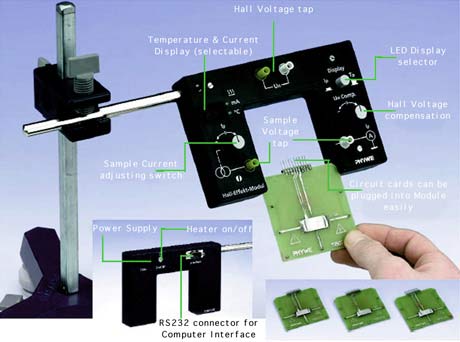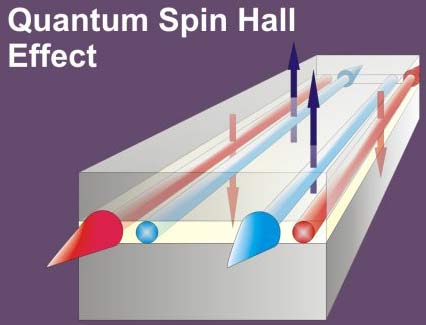Quantum Hall effect in HGTe
German and American physicists have for the first time observed the first signs of an unusual solid phenomenon called the Quantum spin Hall effect (QSHE), in which electrons flow Spin spins at the edge of the insulator can become electrically conductive.
Researchers have observed marginal electrical conductivity in mercuric mercury plates (HgTe) although in practice they cannot be certain that the fringe electrons are polarized spins. QSHE is an interesting effect because it will be extremely useful for creating spintronic components, simultaneously exploiting two electronic properties: charge and spin.
Anyone who learns through the physics base syllabus is very familiar with the classic Hall effect, in which electrons move in thin plates shifted to the two edges of the sample in the presence of the magnetic field due to effect of Lorentz force. This creates an imbalance in charge, leading to the generation of a voltage across the sample. In 1999, physicists for the first time showed evidence of " Spin Hall Effect " in which electrons carry spin up and spin down is deflected to opposite sides of a semiconductor plate and results. is to create spin separation, and create a spin current perpendicular to the current of the current.

The quantum spin Hall effect (QHSE) is a corresponding phenomenon (like the quantum Hall effect relative to the classical Hall effect) that is assumed to occur not in conductors, but in one The number of dielectric samples is very thin. It consists of spin-up electrons that conduct electricity along one edge of the dielectric along with spin-down electrons along another edge. The bandage across the block is dielectric, but the electrical conductivity can be achieved at the edges due to the interaction between the spin with the electronically directed angular momentum (spin interaction - orbit) reducing the band gap ( the energy gap between the conduction band and the valence band) up to 0 for spin-polarized electrons.

Quantum spin Hall effect model.
Last year, Shou-Cheng Zhang and his colleagues at Stanford University (USA) assumed that in very thin sheets of tellurium mercury (HgTe) may have a suitable energy region structure for this phenomenon. And Zhang joined the team of Laurens Molenkamp and colleagues at Wuerzburg University (Germany) to try to find the first experimental evidence of this effect in HgTe quantum wells - HgTe thin films with thickness. Only a few nanometers allow the electrons to be imprisoned in a two-dimensional structure (electronics are limited to one way and move freely in two dimensions).
The electrodes have been connected to the well to allow their conductivity to be measured when cooled to about 30 mK. Other conductivity 0 as assumed by Zhang was observed in all quantum wells ranging in thickness from 6.3 to 12 nm. Because the conductivity does not increase with the thickness of the well, the researchers concluded that conductivity occurs along the edges of the wells rather than occurring in the heart of the material.
However, with wells that are thinner than 6.3 nm, dielectric-like properties occur - consistent with Zhang's theory, predicting that very thin wells will not be able to obtain the appropriate regional structure to occur QSHE. . When the group placed the magnetic field in thicker wells, the fringe conduction disappeared - perfectly consistent with what was predicted in theory.

Results of conductivity and magnetic energy dependence measurement (Science Express).
Although they failed to observe the marginal conductivity, the group still had insufficient evidence to confirm whether the conduction electron was polarizing spin."Of course there will be more work to do" - Charles Kane of the University of Pennsylvania (USA), who predicted that QSHE can occur in ultrathin carbon films (called graphene) - "But I don't think it can lessen the importance of this work ".
Molenkamp told Physics World, the team is exploring the possibility of how SQUID magnetic probes can be integrated in quantum wells to measure spin polarization at the edges. And because polarized spin electrons are expected to produce loss of electrical conductivity, marginal conductive dielectrics can be used in low-power spintronic components.
(Details in the article just published in Science Express ).
The Doctrine of Independence
- Using light alters superconducting properties
- China set a surprising record of quantum entanglement
- Quantum effect in diamonds
- Materials that help the phone do not need to be charged
- How far has the quantum computer developed?
- Light granular or waveform?
- Chinese satellites pass encryption can not be cracked
- Independent hall Independence Hall - United States of America
- What is quantum computing and its importance to people?
- Successfully fabricated quantum circuit breaker
- China successfully developed the world's first quantum computer
- For the first time, quantum computers have been proven to be more powerful than classical computers
 Daily use inventions come from universities
Daily use inventions come from universities Special weight loss device helps prevent appetite
Special weight loss device helps prevent appetite 8 inventors were killed by their own inventions
8 inventors were killed by their own inventions Iran invented a motor car powered by water
Iran invented a motor car powered by water